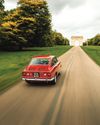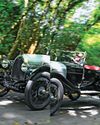Hand-built for discerning buyers, the Mercedes Universal and Vanden Plas Countryman are the zenith of ’60s estates.

There are a number of parallels between the two exceptionally rare and desirable shooting brakes basking in the magnificent grounds of Stonor Park in Oxfordshire. Both are coach built, both are derived from middle-class saloon cars that made their debuts in 1959 and both have Belgian connections. But that is almost where the comparisons cease, because the Mercedes-Benz 230 Universal and the Vanden Plas Princess 3-Litre Countryman are quite different forms of motoring life.
It is sometimes forgotten that Daimler-Benz would not offer a factory-built wagon until the W123 in 1977, but 20 years earlier the Borgward Isabella Combi had established the estate car as a respectable form of transport with no light commercial overtones. From 1955 the Mercedes Ponton had been available with a station wagon conversion by Binz of Lorch, and this tradition continued with the introduction of the four cylinder W110 190c and 190Dc Fintails in 1961. Importateur des Moteurs et d’Automobiles (IMA) of Belgium – which had been assembling Mercedes saloons for the local market since 1954 – created its Universal estate in 1965, and in ’66 West German dealers began to offer it as the first ‘official’ Mercedes station wagon.
The initial Universals were based on the 190 and 190D, and then, after the facelift of the Fintail range in the autumn of 1965, the 200, 200D, 230 and 230S. Floorpans and doors were shipped from Sindelfingen and the engines from Untertürkheim. In addition to fabricating a new roof, rear panels, inner rear wings and tailgate, IMA also used several Belgian-sourced materials, such as the glass. The weight penalty compared to the saloon was a mere 105kg and all Universals, apart from the 190, had an IMA-developed self levelling air-suspension system to compensate for any extra load. Options included a third row of seats, a 60:40 split rear backrest, a bench front seat and automatic transmission.
Denne historien er fra March 2017-utgaven av Classic & Sports Car.
Start din 7-dagers gratis prøveperiode på Magzter GOLD for å få tilgang til tusenvis av utvalgte premiumhistorier og 9000+ magasiner og aviser.
Allerede abonnent ? Logg på
Denne historien er fra March 2017-utgaven av Classic & Sports Car.
Start din 7-dagers gratis prøveperiode på Magzter GOLD for å få tilgang til tusenvis av utvalgte premiumhistorier og 9000+ magasiner og aviser.
Allerede abonnent? Logg på

RAY HILLIER
Double-chevron oddity proves a break from the norm for this Crewe specialist

SHORT BACK & GLIDES
Eccentric enthusiast Captain RG McLeod's series of Manx-tailed Bentley Specials reached its zenith with this unique S2 Continental.

People's choice
The diminutive but multi-million-selling Fiat 850 packed a remarkable diversity of form and function into its compact footprint

PLASTIC BREAKS FROM THE NORM
Glassfibre revolutionised niche car-body production, but just occasionally strayed into the mainstream.

A SENSIBLE SUPERCAR
The cleverly conceived four-seater Elite secured Lotus a place at the big players' table, but has it been unfairly maligned since then?

"I had a habit of grabbing second place from the jaws of victory"
From dreams of yachting glory to the Le Mans podium, via a stint at the top of the motorsport tree, Howden Ganley had quite the career

Still going strong
Herbert Engineering staked its reputation on the five-year warranty that came with its cars. A century on, this Two Litre hasn't made a claim

One for the kids
General Motors was aiming squarely at the youth market with the launch of the Pontiac GTO 60 years ago, and its runaway success popularised the muscle-car movement

A NEW BREED OF HERO
Launched at the turn of the millennium, the GT3 badge has already earned a place alongside RS, CS and turbo in Porsche lore.

Brits with SIX appeal
The straight-six engine is synonymous with a decades-long legacy of great British sports cars. Six variations on the sextet theme convene for comparison